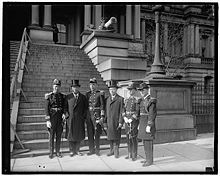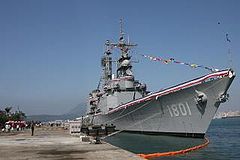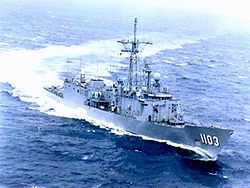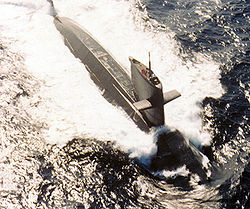- Republic of China Navy
-
Not to be confused with People's Liberation Army Navy (PLAN), the naval forces of the People's Republic of China (PRC).
Republic of China Navy 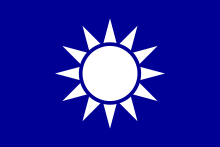
Leadership Ministry of Defense Commands Republic of China Marine Corps Personnel Rank insignia Equipment Ships History and Traditions Naval history of China Orders, Decorations and Medals List of orders, decorations and medals Order of Blue Sky and White Sun The Republic of China Navy (中華民國海軍; pinyin: Zhōnghuá Mínguó Hǎijūn) is the maritime branch of the Armed forces of the Republic of China (Taiwan). The ROC Navy's primary mission is to defend ROC territories and the sea lanes that surround Taiwan against a blockade, attack, or possible invasion by forces of the People's Republic of China. Operations include maritime patrols in the Taiwan Strait and surrounding waters, as well as counter-strike and counter-invasion operations during wartime. The Republic of China Marine Corps functions as a branch of the Navy.
The ship prefix for ROCN combatants is ROCS (Republic of China Ship); an older usage is CNS (Chinese Navy Ship).
Contents
Organization
Republic of China Navy 
Naval Jack of the Republic of ChinaActive 1924-present Country  Republic of China
Republic of ChinaSize 38, 000 personnel
4 Destroyers
22 Frigates
4 Minesweepers
1 Dock Landing Ship
2 Tank Landing Ships
4 SubmarinesCommanders Commander In Chief, ROCN Admiral Wang Li-Shen[1] Insignia Insignia 
- Navy General Headquarters (海軍總司令部)
- Navy GHQ is subordinate to the General Staff, the Minister of Defense, and the ROC President.
- Internal units: Personnel, Combat Readiness & Training, Logistics, Planning, Combat Systems, General Affairs, Comptroller, Inspector General, Political Warfare.
- Naval Fleet Command (艦隊司令部)
-
- 124th Fleet: Tsoying District, Kaohsiung City
- 131st Fleet: Keelung City, Taiwan Province
- 146th Fleet: Makung, Penghu, Taiwan Province
- Amphibious Fleet (151st Fleet), Tsoying District, Kaohsiung City
- 168th Fleet: Suao, Yilan County, Taiwan Province
- 192nd Fleet (Navy Minesweeper Fleet): Tsoying District, Kaohsiung City
- 256th Submarine Squadron: Tsoying District
- 261st Squadron
- Hai Chiao(Sea Dragon) PGMG Guided Missile Boat/Craft Group (海蛟大隊)
- 1st Hai Chiao Guided Missile Boat/Craft Squadron of 10 Hai Ou class missile boat (Dvora class)
- 2nd Hai Chiao Guided Missile Boat/Craft Squadron of 10 Hai Ou class missile boat (Dvora class)
- 3rd Hai Chiao Guided Missile Boat/Craft Squadron of 10 Hai Ou class missile boat (Dvora class)
- 4th Hai Chiao Guided Missile Boat/Craft Squadron of 10 Hai Ou class missile boat (Dvora class)
- 5th Hai Chiao Guided Missile Boat/Craft Squadron of 10 Kuang Hua VI class missile boat[2][3]
- Hai Feng Shore Based Anti-ship Missile Group (海鋒大隊), operates 6 batteries of fixed/mobile HF-2 anti-ship missiles.
- Aviation Command (operates from Pingtung, Tsoying, Hualien, and Taoyuan AB)
-
- Naval Aviation, Taoyuan AB Command, will receive 12 P-3C.
- 1st ASW Aviation Group
-
- 133rd Squadron: S-2T, at Pingtung.
- 134th Squadron: S-2T, at Pingtung.
- 2nd ASW Aviation Group
-
- 701st Helicopter Squadron (Light), S-70C(M)-1, at Hualien.
- 702nd Helicopter Squadron (Light), S-70C(M)-2, at Tsoying.
- 501st Helicopter Squadron (Light), 500MD ASW, at Tsoying.
- Maintenance Group
-
- 1st Maintenance Squadron (Pingtung)
- 2nd Maintenance Squadron (Tsoying)
- 3rd Maintenance Squadron (Hualien)
- Marine Corps Command (陸戰隊司令部)
- Education, Training and Doctrine Command(教育訓練暨準則發展司令部)
- Logistics Command (後勤司令部)
- Naval Academy, Hydrographic & Oceanographic Bureau, Shipbuilding Development Center, Communication Systems, General Service.
History
1911–1949
See also Naval history of China.
The precursor to the modern ROC Navy was established as the Ministry of the Navy in the Provisional Government of the Republic of China in 1911 following the overthrow of the Qing dynasty. During the period of warlordism that scarred China in the 1920s and 1930s the ROCN remained loyal to the Kuomintang government of Sun Yat-sen instead of the warlord government in Beijing. During that time and throughout World War II, the ROCN concentrated mainly on riverine warfare as the poorly equipped ROCN was not a match to Imperial Japanese Navy over ocean or coast.[10]
Following World War II, a number of Japanese destroyers and scrapped U.S. ships were transferred to the ROC Navy. During the Chinese Civil War, the ROCN was involved in the protection of supply convoys and the withdrawal of the ROC Government and over 1+ million refugees to Taiwan in 1949. The subsequent reorganization and reestablishment of the Navy after evacuation to Taiwan is referenced in the lyrics of the post 1949 ROC Navy Song "The New Navy" (新海軍).
1949–Present
Following the relocation of the ROC government to Taiwan, the ROCN was involved in a number of commando attack escorts, evacuation and transport more soldiers displaced and later to provide patrols and resupply operations to Kinmen and Matsu in the Taiwan Strait and South China Sea offshore islands.
Since the 1990s the Navy has grown in importance as the emphasis of the ROC's military doctrine moves towards countering a possible PRC blockade, as well as offshore engagement. The ROCN has been working hard to expand its capability in electronic and anti-submarine warfare, as well as the replacement of its current antiquated fleet.[8]
Equipment
See also: List of ships of the Republic of China Navy
Traditionally, most ROCN equipment is purchased from the United States, though several ships have been built domestically under licence or through domestic development. The ROCN has also purchased Lafayette class frigates from France and Zwaardvis class submarines from the Netherlands as well as well as four U.S. Kidd class (renamed Keelung) destroyers originally intended for Iran.
Despite the ROCN refurbishing and extending the service life of its vessels and equipment, it has suffered from procurement difficulties due to pressures exerted by the PRC. It has only two useful submarines. The U.S. has approved sales of eight new diesel powered submarines but lacks the manufacturing capability to make the engines; at the same time, threats from the PRC prevent the necessary technology transfer from other countries. Furthermore, the Legislative Yuan did not approve the budget and thereby slowed the opportunity to procure the badly needed underwater defense capability.
On September 12, 2007, an arms notification was sent to the U.S. Congress concerning an order for 12 P-3C Orion patrol aircraft and 3 "spare aircraft", along with an order for 144 SM-2 Block IIIA surface-to-air missiles.[11] A contract was awarded to Lockheed Martin to refurbish the 12 P-3C Orion aircraft for the ROC on March 13, 2009, with deliveries to start in 2012.[12]
On August 26, 2008, an arms notification was sent to Congress for an order for 60 air launched Harpoon Block II missiles for the 12 P-3C.[13]
On October 3, 2008, an arms notification was sent to Congress for an order for 32 submarine launched Harpoon Block II missiles.[14][15] At least a portion of these missiles will be installed on the navy's Hai-Lung class submarines.
On January 29, 2010, the U.S. government announced 5 notifications to the U.S. Congress for arms sales to the ROC. In the contracts total 6.392 Billion USD, ROC Navy will get 2 Osprey class mine hunters for 105 million USD,25 Link 16 terminals on ships for 340 millions, 10 ship and 2 air launched Harpoon L/II for 37 millions.[16][17]
The ROC Navy already has 95 older Harpoon missiles in its inventory for the 8 Knox frigates, 22 newer RGM-84L for the 4 Kidd DDGs, 32 sub launched Harpoon II on order for the 2 Zwaardvis/Hai Lung submarines, and with 60 air launched Harpoon Block II anti-ship missile on order for the 12 P-3C, plus the newly announced 10 ship launched and 2 air launched Harpoon II/L sales.[18]
On August 31, 2010, it was announced for next year's defense budget, ROCN plan to lease 1 or 2 more Newport LSTs from US, but the 900 ton stealth corvette plan has been put on hold, due to lack of budget.[19]
On September 29, 2010, the U.S. Congress passed resolution, authorizing U.S. government for sales of 1 more Osprey class mine hunter to the ROC.[20]
Other ongoing locally upgrade program includes Ching Chiang class patrol ship that were designed back in 1990s to carry 4 HF-1 anti-ship missiles on board but only the lead boat had them. Since 2006, 7 ships of this class were upgraded to carry 4 HF-2/3 with W-160 fire control radar from Wu Chin III program (as well as Honeywell H-930 MCS CDS stripped from 7 retired Yang class Wu Chin 3 AAW DDGs). On 2010 it was found more ships of this class undergoing this same upgrade program but using CSIST produced fire control radars instead.
On December 29, 2010, 2 LST(中肇、中治戰車登陸艦) and remaining of the 4 Adjutant class coastal mine hunters were retired.[21]
On October 31, 2011, all 8 PCL in 124th Fleet, retired.[22]
Combatants
Type Class Number Builder Notes Destroyer Kee Lung Class 4 Ingalls Shipbuilding ex-Kidd class Frigate Cheng Kung Class 8 CSBC Corporation long hull Oliver Hazard Perry Class design Frigate Chi Yang class frigate 8 Lockheed/Avondale ex-Knox class Frigate Kang Ding Class 6 DCNS La Fayette class variant Submarines
Class Number Builder Origin Hai Lung class submarine (Zwaardvis class) 2 Rotterdam Dockyard Company Submarines  Netherlands
NetherlandsHai Shih class submarine (Tench class) 2 Portsmouth Naval Shipyard  United States
United StatesFast Attack Missile Craft and Patrol Ship
Class Number Builder Origin Ching Chiang class patrol ship 12 CSBC Corporation  Republic of China
Republic of ChinaKuang Hua VI class missile boat 29 (class of 31 completed by 2011) CSBC Corporation  Republic of China
Republic of ChinaHai Ou class missile boat (Dvora class) 50 mostly built in Taiwan. Less than 40 exist, replacing by KH-6 missile craft CSBC Corporation, Taiwan  Republic of China
Republic of China
Minesweepers
Class Number Builder Origin Yung Yang class minesweeper (Aggressive class) 4 J.M. Martinac Shipbuilding Corp.  United States
United StatesYung Feng class coastal minehunter (MMW50 class) 4 Abeking & Rasmussen  Germany
GermanyOsprey class coastal minehunter 3 (on order, announced) Intermarine USA  United States
United StatesAmphibious
Class Number Builder Origin Hsuhai class dock landing ship (ex-USS Pensacola LSD-38) 1 General Dynamics-Quincy  United States
United StatesChung Cheng class dock landing ship (ex-USS Comstock LSD-19) 1 Newport News Shipbuilding  United States
United StatesChung Ho class tank landing ship (Newport class) 2 Philadelphia Naval Shipyard  United States
United StatesChung Hai class (LST-1) 7 Newport News Shipbuilding  United States
United StatesMei Chin class (LSM-1) 4 Charleston Shipbuilding and Dry Dock Co.  United States
United StatesSupport
Class Number Builder Origin Wu Yi class fleet oiler 1 CSBC Corporation  Republic of China
Republic of ChinaTa De class (ARS-556) salvage tug (ex-USS Recovery ARS-43) 1 Basalt Rock Inc.  United States
United StatesTai Hu class (ARS-552) salvage tug (ex-USS Grapple ARS-7) 1 Basalt Rock Inc.  United States
United StatesTa Tung class (ATF-548) fleet tug (ex-USS Chickasaw AT-83) 1 Charleston Shipbuilding and Drydock Co.  United States
United StatesTa Kuan oceanographic research ship 1 Fincantieri, Muggiano, La Spezia, Italy  Italy
ItalyChung Bai class coastal logistics tankers (ex-USS Pecatonica AOG-57) 2 Seattle-Tacoma Shipbuilding Corp.  United States
United StatesWu Kang class coastal transports 2 CSBC Corporation  Republic of China
Republic of ChinaWan An coastal transport 1 CSBC Corporation  Republic of China
Republic of ChinaTai Wu coastal transport 1 CSBC Corporation  Republic of China
Republic of ChinaAircraft
Aircraft Origin Type Versions In service[23] Notes Grumman S-2 Tracker  United States
United StatesMaritime patrol aircraft S-2T Turbo Tracker 26, half operational Originally 32 were upgraded to T version, but only 27 were converted Lockheed P-3C Orion  United States
United StatesMaritime patrol aircraft P-3C Orion 12 Ordered, plus 3 spare airframes Sikorsky S-70 Seahawk  United States
United StatesNaval utility/ASW helicopter S-70C(M)-1/2 Thunderhawk 19 Out of 10+11 ordered Hughes 500MD/ASW Defender  United States
United StatesASW helicopter Hughes 500MD/ASW Defender 9 Out of original 13 ordered Planned Acquisition
- Hsun Hai (Swift Sea) program
See also
References & notes
- ^ http://hup.sub.uni-hamburg.de/giga/jcca-cds/article/viewFile/188/188
- ^ "First KH-6 squadron entered service as 5th Sea Dragon Squadron". Central News Agency. http://www.cna.com.tw/ShowNews/WebNews_Detail.aspx?Type=FirstNews&ID=201005180032. Retrieved 2010-5-18.
- ^ "First KH-6 squadron entered service". pchome.com.tw. http://news.pchome.com.tw/politics/bcc/20100518/index-12741579392278421001.html. Retrieved 2010-5-18.
- ^ "Red Roof Tiles and White Walls, Hidden Missile Base Next To Hotel.". United Daily News. http://udn.com/NEWS/NATIONAL/NAT5/6041681.shtml. Retrieved 2010-12-23.
- ^ "Navy opens missile base in eastern Taiwan to media". The China Post. http://www.chinapost.com.tw/taiwan/national/national-news/2010/12/18/284177/Navy-opens.htm. Retrieved 2010-12-23.
- ^ "ROC Navy opens missile base in eastern Taiwan to media". China Defense Blog. http://china-defense.blogspot.com/2010/12/roc-navy-opens-missile-base-in-eastern.html. Retrieved 2010-12-23.
- ^ "Navy - Overview". GlobalSecurity.org. http://www.globalsecurity.org/military/world/taiwan/navy-overview.htm. Retrieved 2006-03-08.
- ^ a b "2004 National Defense Report" (PDF). ROC Ministry of National Defense. 2004. Archived from the original on March 11, 2006. http://web.archive.org/web/20060311012134/http://report.mnd.gov.tw/eng/pdf/all-1-360.pdf. Retrieved 2006-03-05.
- ^ "Combat Units Under the ROC Navy Fleet HQ". Taiwanmilitary.org. http://www.taiwanmilitary.org/phpBB2/viewtopic.php?t=8220. Retrieved 2006-03-08.
- ^ "歷史傳承 (History)". ROC Navy. http://navy.mnd.gov.tw/Publication.aspx?CurrentNodeID=506&Level=2&PublicID=910. Retrieved 2006-03-08.[dead link]
- ^ "Pentagon could make 2.2 billion dollar arms sales to Taiwan". Yahoo! news. 2007-09-13. http://au.news.yahoo.com/070912/19/14evg.html. Retrieved 2007-09-13.[dead link]
- ^ "U.S. in deal to refurbish aircraft for Taiwan". Washington Post. 2009-03-13. http://www.washingtonpost.com/wp-dyn/content/article/2009/03/13/AR2009031302806.html. Retrieved 2007-09-13.[dead link]
- ^ Jennings, Ralph (2008-08-27). "U.S. to sell anti-ship missiles to Taiwan". Reuters. http://www.reuters.com/article/idUSTP4816220080827.
- ^ The Washington Post. http://www.washingtonpost.com/wp-dyn/content/article/2008/10/03/AR2008100303240.html.[dead link]
- ^ http://asia.news.yahoo.com/081003/afp/081003211458asiapacificnews.html
- ^ "USDA New Release". dsca.mil. 2010-01-29. http://www.dsca.osd.mil/PressReleases/36-b/2010/Taiwan_09-39.pdf. Retrieved 2010-01-29.
- ^ "USDA New Release". dsca.mil. 2010-01-29. http://www.dsca.osd.mil/PressReleases/36-b/2010/Taiwan_09-37.pdf. Retrieved 2010-01-29.
- ^ "armstrade.sipri.org". armstrade.sipri.org. http://armstrade.sipri.org/armstrade/page/trade_register.php. Retrieved 2010-01-10.
- ^ "Next Year Defense Budget Believed To Be Lowest In 5 Years". United Daily newspaper. 2010-08-31. http://udn.com/NEWS/NATIONAL/NAT1/5819074.shtml. Retrieved 2010-09-12.
- ^ "US Congress approved sales of mine hunter to Taiwan". United Daily News. 2010-09-30. http://udn.com/NEWS/NATIONAL/NAT1/5879758.shtml. Retrieved 2010-09-30.
- ^ "6 Navy ships retired.". Youth Daily News. 2010-12-29. http://news.gpwb.gov.tw/newsgpwb_2009/news.php?css=3&nid=160392&rtype=2. Retrieved 2010-12-29.
- ^ "All 8 Navy PCL Retired Into History.". Military News Agency. 2011-10-31. http://163.29.207.53/MNANew/Internet/NewsDetail.aspx?GUID=62890. Retrieved 2011-11-01.
- ^ "Naval Aviation Command". Globalsecurity.org. http://www.globalsecurity.org/military/world/taiwan/rocnavair.htm. Retrieved 2007-07-16.
External links
Republic of China Armed Forces Branches Army · Navy · Marine Corps · Air Force · Military Police
Organizations Ministry of National Defense · National Security Bureau · Chungshan Institute of Science and Technology · Veterans Affairs CommissionEquipment Sky Bow · Sky Sword I / II · Wan Chien · Hsiung Feng I / II / IIE / III · IDF Ching-kuo · CM-32 · T65 / T86 / T91 assault rifle · T93 sniper rifleIssues Weapons of mass destruction · Political status of Taiwan · Taiwan independence · Taiwan Strait crises (1955/1958/1996)Command Centers Heng Shan Military Command Center · Yuan Shan Military Command CenterCategories:
Wikimedia Foundation. 2010.


